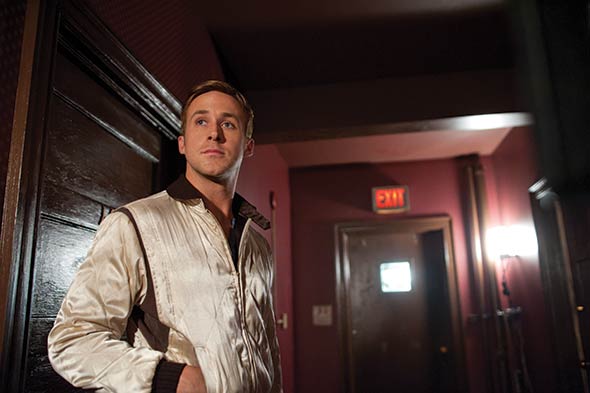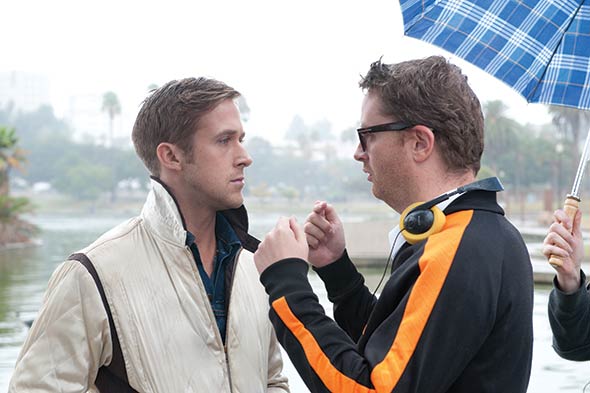

The circulating story of Drive revolves around an awkward silence between two men broken by REO Speedwagon’s “I Can’t Fight this Feeling Anymore,” sung obnoxiously by a Dane hopped up on flu medication. The voice in question belonged to Nicolas Winding Refn, a self-professed “fetish filmmaker” from Copenhagen whose Pusher trilogy and recent English-language films have developed a cult following among Europeans and europhiles alike and earned him the audience of actor Ryan Gosling, who happened to flip on the radio in that moment of fateful blind date discomfort. The rare bond that soon developed between the director and actor has drawn comparisons to infamous Hollywood pairings such as Robert DeNiro and Martin Scorsese, and the two will be collaborating again for Refn’s upcoming film as well as a remake of Logan’s Run.
Drive, much like Refn’s last two films Valhalla Rising and Bronson, have won the Danish director both critical praise and dissent, their use of violence deemed at once disruptive and profound and their pulp, sleek imagery and scores earning references to Quentin Tarantino and accusations of producing derivative work. The polarized critical reaction to Drive unsurprisingly led to Refn snatching up the Best Director award at Cannes this past spring, and Cliff Martinez’s flawless, pulsing score, complete with effeminate pop hits like College’s “A Real Hero,” have kept the soundtrack at the top of the iTunes charts in a number of countries since the film’s release.
“Drive is about a man who becomes a superhero,” said Refn of Gosling’s unnamed protagonist in the film—a gifted stunt driver and mechanic in LA by day and an unflinching getaway driver by night. We caught up with the director over the phone while he prepped his next film, Only God Forgives, in Bangkok.
I’ve read in a number of places that you had several of the actors living with you throughout production. Is that a common habit for you? Well not as much as it turned out to be, but it was probably a great way to do a movie in Los Angeles. It was very communal, you know. Carey [Mulligan] moved in because she didn’t have a place to live in Los Angeles. The editing was done there too, and then Hossein Amini, who was writing with me, was living in the attic. Ryan [Gosling] had his own key, basically, so he would just come by all the time. I very rarely left the house, unless I really had to go somewhere else. And it also didn’t help that I don’t drive.
There’s been a number of rumors floating around about how you met Ryan, some of them involving too much cough medicine. Tell me about that experience.
Well the origin of that is that I was in Los Angeles to do a movie with Harrison Ford… There was a great script that Paul Schrader had given me, about a CIA agent who basically goes on an existential journey and dies. It turns out that Harrison Ford didn’t want to die, and I was really pissed off at myself for spending so much time in LA and working on this film. Out of the blue, I got a call from Ryan Gosling, and he asked if I would like to meet him. We were supposed to have dinner, but I had a very high fever and felt a flu coming on, and Harrison gave me a bunch of flu drugs, which you have in America and are very, very strong, and they instantly made me high as a kite. So when I met [Ryan], I was just so out of it that I could barely have a conversation. And so an hour and a half into the dinner I asked him, “Please take me home.”
One of the greatest things about Drive is the modesty of Driver. How much of that is just Ryan, and how much of that is you directing him? Well it’s a combination, of course. I’m a minimalist person; I think less is more. The way I would work with him is to just tell him to just keep everything inside. And then before each take I would hug him until he gave into the hug, and because he has this incredible ability to say a thousand words without saying a single line, it was a great opportunity to create a character who’s essentially silent.
When did you make the decision to embed Drive in the bleak, sleek look of neon ’80s LA? I don’t do drugs anymore, so music heightens my emotions. In Bronson, I ended up using classical music because the film became an opera. Valhalla Rising is about silence, so we used a lot of distortions [in the soundtrack]. Drive has an electronic score because it represents the beating of the heart of the character—he’s half-man, half-machine. But I didn’t want an aggressive electronic score; I wanted something very feminine to contradict the masculinity and violence of the driver.
How did that first encounter in the car with Ryan influence the soundtrack? I realized that Ryan and I have very similar sensibilities that are very feminine in a way. You can’t be masculine without being feminine. It was definitely the beginning of a good friendship.
TEXT BY William Blake
PHOTOGRAPHY BY Richard Foreman

